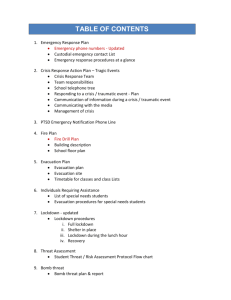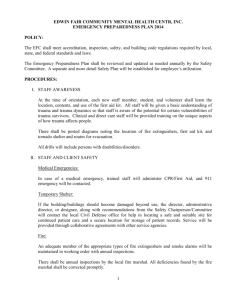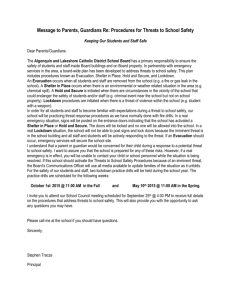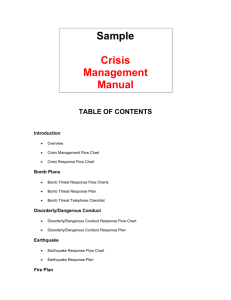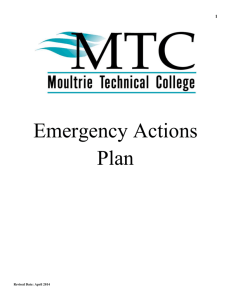Click here for a checklist of strategies you can use to respond to
advertisement
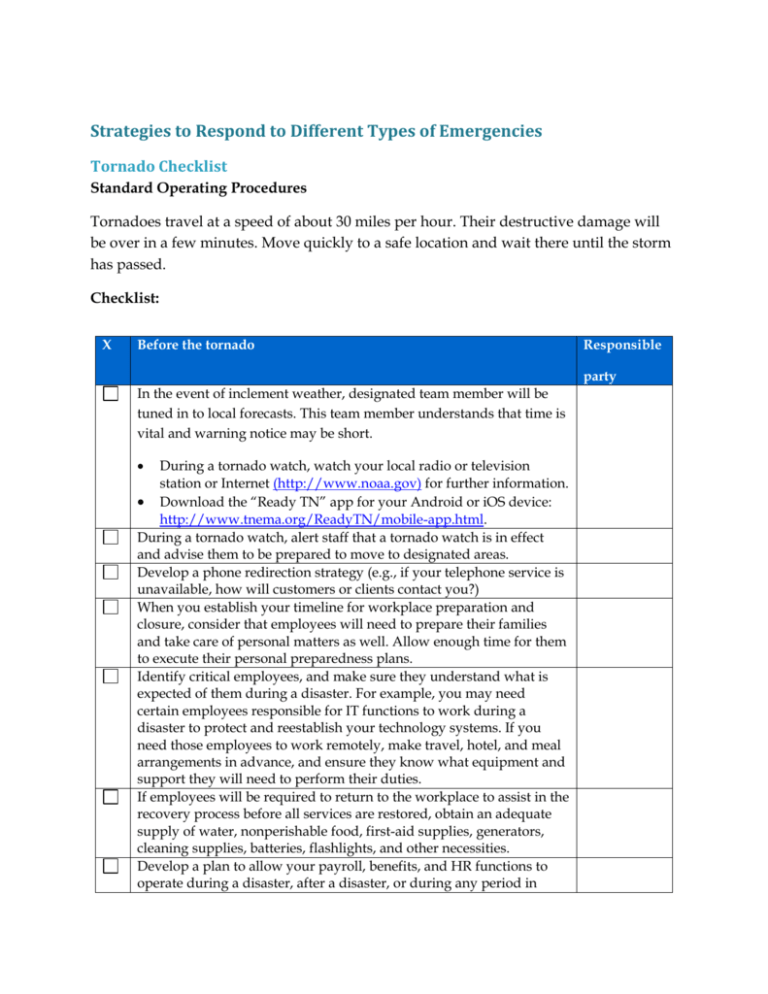
Strategies to Respond to Different Types of Emergencies Tornado Checklist Standard Operating Procedures Tornadoes travel at a speed of about 30 miles per hour. Their destructive damage will be over in a few minutes. Move quickly to a safe location and wait there until the storm has passed. Checklist: X Before the tornado Responsible party In the event of inclement weather, designated team member will be tuned in to local forecasts. This team member understands that time is vital and warning notice may be short. During a tornado watch, watch your local radio or television station or Internet (http://www.noaa.gov) for further information. Download the “Ready TN” app for your Android or iOS device: http://www.tnema.org/ReadyTN/mobile-app.html. During a tornado watch, alert staff that a tornado watch is in effect and advise them to be prepared to move to designated areas. Develop a phone redirection strategy (e.g., if your telephone service is unavailable, how will customers or clients contact you?) When you establish your timeline for workplace preparation and closure, consider that employees will need to prepare their families and take care of personal matters as well. Allow enough time for them to execute their personal preparedness plans. Identify critical employees, and make sure they understand what is expected of them during a disaster. For example, you may need certain employees responsible for IT functions to work during a disaster to protect and reestablish your technology systems. If you need those employees to work remotely, make travel, hotel, and meal arrangements in advance, and ensure they know what equipment and support they will need to perform their duties. If employees will be required to return to the workplace to assist in the recovery process before all services are restored, obtain an adequate supply of water, nonperishable food, first-aid supplies, generators, cleaning supplies, batteries, flashlights, and other necessities. Develop a plan to allow your payroll, benefits, and HR functions to operate during a disaster, after a disaster, or during any period in X which access to your workplace is restricted. Update your employee contact information regularly and at the beginning of any season during which natural disasters are more likely. January/February would be a good time to do so in Middle Tennessee because of the threat of severe weather and flooding during the spring and early summer. Put your crisis management plan in writing and give it to all employees. Designate a shelter area or areas that can adequately fit all of your employees and customers, if applicable. When a tornado warning is issued/during the tornado Responsible party Stay indoors and away from windows. Listen to your radio for the latest information and instructions. Do not tie up the telephone lines. Move personnel to designated shelter areas within the building. Mobile homes/work trailers, even if tied down, offer little protection from tornadoes and should be abandoned. Bring a battery-powered radio and flashlights to the shelter to listen for further developments. Do not use matches or candles, electrical switches or appliances in case there is a gas leak. Rely on flashlights and emergency lighting. During tornado, do not use the telephone for anything other than reporting emergencies. Wait for danger to pass. X After the tornado Responsible party If there are damages, or outages anticipated to last more than 24 hours, the executive team will contact/be contacted to instruct the emergency management team to activate the emergency plan. Assess any injuries or damages and report to management. If there is no damage, assess power sources and conduct a walkthrough to make sure all systems are operative. Flood – Internal and External Standard Operating Procedures The purpose of this section is to provide the framework in which staff can quickly and effectively implement emergency protective actions in response to an internal or external flood. Checklist: X Procedure Description At first sign of excess water on floor, power down all equipment in the area. Contact building maintenance to turn off all power and activate emergency lighting. Try to determine source and cause of water. Attempt to stop flooding if possible. Have personnel move low-lying items to higher places (for example, remove filing cabinet draws and stack them on top of the filing cabinet, etc.) If flooding continues for 10 minutes, enact the evacuation procedures. Assemble in break room (or other designated location) and await instruction from the recovery team manager/alternate. If team manager/alternate is unavailable, proceed to evacuate. Direct and assist in the evacuation of people from the building. a Notify employees to vacate the premises. b Verify that any handicapped individuals are assisted. c Direct the evacuation of visitors from the building. d Check for people in restrooms, storage rooms, and other areas. e Check assigned areas to ensure everyone has evacuated and provide assistance, as needed. Take as many "critical" items as possible with you. Count personnel to confirm all employees are out of building. Direct emergency officials and answer questions. Wait for further instruction from team manager. DO NOT GO HOME OR RETURN TO WORK UNLESS INSTRUCTED TO DO SO. Winter Storm Standard Operating Procedures Responsible Party The purpose of this section is to provide the framework in which staff can quickly and effectively implement emergency protective actions in response to a winter storm threat. Winter storms (blizzard, freezing rain, sleet, etc.) usually provide a few hours' warning. Checklist: X Before the storm X Winter storms (blizzard, freezing rain, sleet, etc.) usually provide a few hours' warning. Listen to weather reports. Double-check functionality and fuel supply for any available emergency power generators, should they be needed. Keep battery-powered equipment handy (radio, flashlight, etc.). Provision supplies. Names and phone numbers of your heating contractor, plumber, fire department, insurance agent, building owner, and facilities manager should be easily accessible. Once an impending winter storm has been announced, Executive management assesses situation in light of emergency levels and assessment matrix. Executive management issues incident action plan and convenes emergency management team to: Decide appropriate action (business as usual; activate remote access for critical workers; pre-stage alternate location; workforce re-deploy). Coordination with critical customers. For critical business functions, review the list of critical employees and communicate expectations. Use emergency communications checklist to communicate with vendors and customers about conducting business in potential degraded environment. Administration recovery team readies any sheltering needs for employees. During the storm Keep driveways, walkways, and doorways clear of snow and ice. Open water faucets slightly to let them drip so that water keeps flowing through the pipes and makes freezing less likely. Activate the communications tree, communicating the approved information to employees. Have employees fuel Responsible party Responsible party automobiles prior to the storm hitting. (Gas stations may be inoperable for many days after the storm due to interrupted power.) Have someone assigned to check indoor temperatures at your place of business if power is interrupted for a period of time and/or the building is vacant. Administration recovery team provides temporary bedding and food for employees who might be required to stay overnight. Executive management maintains regular conference bridge call. Monitor emergency levels. Maintain communications using emergency communications checklists. Chemical Spill Standard Operating Procedures: The purpose of this section is to provide the framework in which staff can quickly and effectively implement emergency protective actions in response to a chemical spill. Checklist: X Procedure description If an internal or external chemical spill/release is detected, contact local officials. Convene the emergency management team. Local officials will determine if the area is to be evacuated. If the chemical spill is within your building, evacuate staff. If the chemical spill is outside your building, turn off air intake handlers. Use plastic sheeting and duct tape to seal windows, exhaust fan openings and bay doors. If contamination is airborne, officials will direct an evacuation of all persons located downwind of the spillage area. Follow evacuation procedures as directed by officials and security. DO NOT drink any tap water; contamination is likely (beverages in sealed containers should be drinkable). If officials direct people to return home, use check-out process directed by security. Team manager/alternate should contact recovery team manager to receive instructions. If evacuation is deemed necessary, follow evacuation procedures. Responsible party Shut off all equipment while evacuating. DO NOT collect personal belongings. GO HOME if you have your own transportation. Stay home until further instructions from the team manager. If your home is in the evacuation area, contact the team manager with your temporary location. The emergency management team convenes at backup location, makes decisions about business resumption, and activates communications tree. Bomb Threat Standard Operating Procedures The purpose of this section is to provide the framework in which staff can quickly and effectively implement emergency protective actions in response to a bomb threat. Checklist: X Prevention of a bomb being placed Responsible party Keep work areas clean and orderly. Report anything that appears out of the ordinary. Keep closets locked when possible. X If you find a suspicious package or device, DO NOT ATTEMPT TO TOUCH OR REMOVE IT. Be observant for any unidentified person(s) who act strangely, seem overly curious, or ask unusual questions. Response to a bomb threat If the threat is by letter or note: Remain calm. Call 9-1-1 as soon as possible to report the threat. Contact the emergency director or business continuity coordinator. Make every possible effort to retain evidence such as fingerprints, handwriting, paper, postal marks or any other means to trace its origin. If the threat was hand-delivered, write down a Responsible party description of the person who delivered the letter or note. Also, note information about anyone accompanying the person, as well as his/her mode of transportation and direction of travel. If the threat is by telephone: Remain calm. Call 9-1-1 as soon as possible to report the threat. Immediately refer and complete a details list. Notify the business continuity coordinator or emergency director, who will alert the staff to evacuate the building until it is safe to go back in. If the threat is in person: Remain calm. Call 9-1-1 as soon as possible to report the threat. Be observant; find out as much as possible (when, where, why, what, who). Notify the emergency director or business continuity coordinator, who will alert the staff to evacuate the building until it is safe to go back in. After the bomb threat situation has been completed, complete a debriefing session for all staff involved to see if any individual needs additional assistance.

